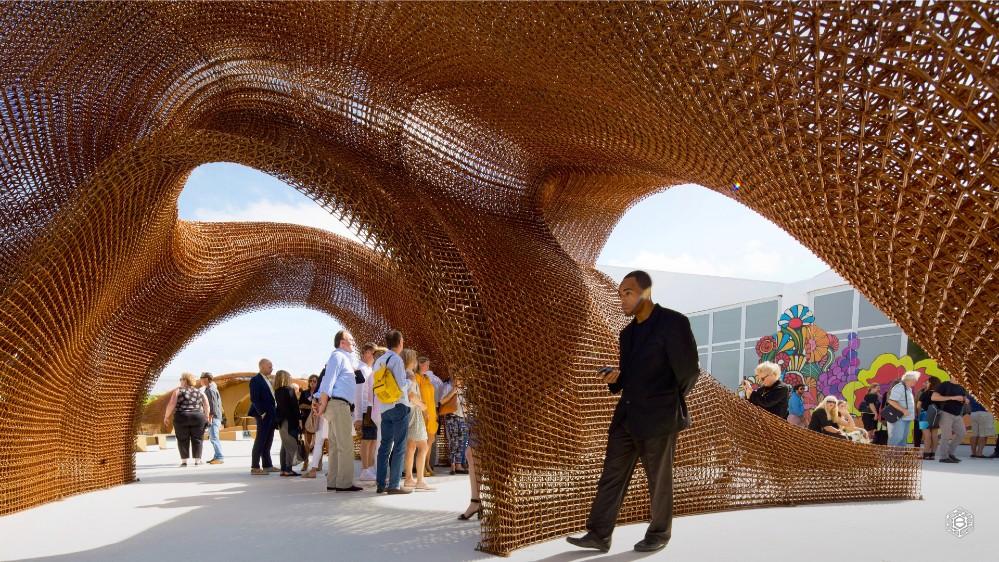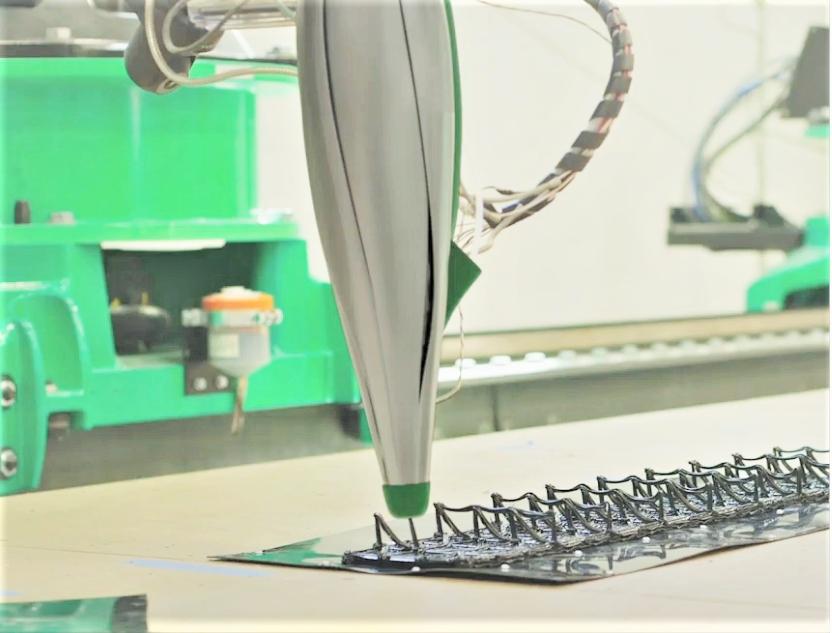- FMA
- The Fabricator
- FABTECH
- Canadian Metalworking
Our Publications
Categories
- Additive Manufacturing
- Aluminum Welding
- Arc Welding
- Assembly and Joining
- Automation and Robotics
- Bending and Forming
- Consumables
- Cutting and Weld Prep
- Electric Vehicles
- En Español
- Finishing
- Hydroforming
- Laser Cutting
- Laser Welding
- Machining
- Manufacturing Software
- Materials Handling
- Metals/Materials
- Oxyfuel Cutting
- Plasma Cutting
- Power Tools
- Punching and Other Holemaking
- Roll Forming
- Safety
- Sawing
- Shearing
- Shop Management
- Testing and Measuring
- Tube and Pipe Fabrication
- Tube and Pipe Production
- Waterjet Cutting
Industry Directory
Webcasts
Podcasts
FAB 40
Advertise
Subscribe
Account Login
Search
Robotic 3D printing system builds large, lightweight structures in free-space
Branch’s C-Fab process uses 20 times less material than traditional 3D printing techniques
- By Holly B. Martin
- March 23, 2021
- Article
- Additive Manufacturing

Branch Technology’s Cellular Fabrication process allows build materials to solidify in free space without dimensional restrictions or support structures. Shown are 3D-printed pavilions for an exhibit in Miami. Images: Branch Technology
Branch Technology is a prefabrication construction and technology company that specializes in 3D-printing large-scale facades, walls, pavilions, sculptures, and other architectural components and polymer structures.
Among the goals of the Chattanooga, Tenn., company is to provide architects unprecedented design freedom through the use of its Cellular Fabrication (C-Fab) technology. The patented process combines industrial robots, powerful algorithms, and the company’s Freeform extrusion process that allows huge structures to be 3D-printed without supports.
Branch says C-Fab permits the creation of structures that would be impossible to make by traditional construction techniques.
Freedom From Tradition
The company was founded in 2013 by architect and current CEO Platt Boyd, who wondered whether 3D printing an open cellular matrix would create something strong yet efficient for the construction trade. The traditional fused-filament style of 3D printing—adding one layer of material upon another—not only consumes large quantities of material but also produces very heavy objects.
Looking at nature, Boyd saw that large objects such as trees and the human body are built on a matrix of microscopic cell walls, resulting in a mostly open structure. When combined with other materials, like cytoplasm in the case of humans, the result is a composite material that supports the entire organism.
“When Boyd first started looking into the idea of cellular 3D printing, he discovered that the technology didn’t exist, so he decided to invent it,” said Mitch Lewandowski, Branch’s chief commercial officer. “Fast forward seven years and we’ve been able to develop the software and hardware to productize our cellular fabrication method. We’re already able to do some amazing things with this technology, and it’s absolutely taking off from here.”
Enter the Giant Robots
With its 12-ft. tall, 6-axis, custom-green industrial robots built by Kuka, Branch can print parts up to 8 by 8 by 35 ft. in a single print. The robots move along tracks, giving them a total of seven axes of freedom.
The current fleet includes 17 additive robots and two subtractive, with five more on the way. Eventually, the company’s new 50,000-sq.-ft. advanced design and manufacturing center will house around 40 robots.
The printing material the robots build structures from is neither filament nor liquid. It’s a pelletized, proprietary polymer conveyed through a complex network of hoppers, hoses, and drying mechanisms. The pellets are melted then extruded in a crisscrossed open matrix.
The technology allows extruded material to solidify in free space without dimensional restrictions and eliminates the need for support structures. C-Fab objects can be made from 20 times less material than those produced by traditional layering approaches.
Once panels are printed at the factory, they are shipped to the site where they are installed with industry-standard rainscreen hardware and custom-engineered structural attachments, or integrated into a building’s outer covering.
In addition to its printing technology, Branch uses an end-to-end, patented digital hardware and software system developed completely in-house, said Lewandowski. “We can take a client’s model from any CAD application and bring it into our platform, where our proprietary software ‘panelizes’ it, breaking a large structure into shippable pieces. Then it plans the tool path for printing the panels and pushes that code out to the robots.”
Printed matrices can be filled with insulating or fireproofing foam, be milled, then have a weatherproof finish such as glass fiber-reinforced concrete applied. If left unfilled and milled, matrices can serve as sculptures or pavilions.
Prefab 3D
Unlike other additive manufacturing companies in the building industry, Branch Technology focuses on prefabrication and modular construction, which provide a more reliable environment for quality control of products and project timelines.
“Printing buildings on the job site using monolithic materials such as concrete exposes those projects to a lot of chaos, from bad weather to vandalism,” said the company’s director of branding and communications, John McCabe. “Prefabrication removes that chaos.”
Traditional construction is “locked in the craftsman’s hands and minds, but that also means the industry hasn’t changed much in hundreds of years, and for the most part, it’s still bricks and sticks,” said McCabe.
One of the problems with the old model is the amount of waste generated. “It’s a huge amount,” he said. “But prefabrication fixes a lot of that.”
Along with waste reduction, prefab construction enhances environmental stewardship in other ways. “We want our materials to be … lightweight to minimize the environmental effects of shipping,” McCabe said. “And we want to be able to recycle materials. Our polymer can be recycled up to four times inside our factory, so there’s almost no waste at all.”
The company’s in-house scientists continuously investigate and test new materials for the C-Fab process. The current portfolio includes carbon-fiber and ABS mixtures, as well as biopolymers, including one derived from sugar cane that smells like cookies out on the factory floor, according to McCabe.
NASA Challenge
Branch Technology is known for another exotic 3D printing material—one formulated for use in space. In 2017 the company and its partners won first place in NASA’s 3D-Printed Habitat Challenge to build sustainable housing for deep-space exploration.
“According to NASA, each astronaut generates 1.5 pounds of polymer waste a day from tubes and bags, so for the competition we used a mixture of plastic mission waste and basalt rock, which is found on the moon and Mars,” said McCabe. “Our goal in competing was not just to win, but also to develop and test the material, and we are in talks now with NASA and other (Defense Department) organizations about how we move forward.”
For now, the company’s commercial focus is on creating well-designed, code-compliant code-compliant, Instagram-worthy building facades that incorporate complex geometries.
“We do have insulative and structural capabilities, but the value we bring to market for the architectural community is design freedom—now you can do things you couldn’t normally do,” said Lewandowski.
“Construction is the last industry to incorporate robotics and automation,” added McCabe. “We want to get to market and show people how advanced manufacturing can change the way they design and construct buildings.”
About the Author

Holly B. Martin
About the Publication
- Podcasting
- Podcast:
- The Fabricator Podcast
- Published:
- 04/16/2024
- Running Time:
- 63:29
In this episode of The Fabricator Podcast, Caleb Chamberlain, co-founder and CEO of OSH Cut, discusses his company’s...
- Trending Articles
- Industry Events
16th Annual Safety Conference
- April 30 - May 1, 2024
- Elgin,
Pipe and Tube Conference
- May 21 - 22, 2024
- Omaha, NE
World-Class Roll Forming Workshop
- June 5 - 6, 2024
- Louisville, KY
Advanced Laser Application Workshop
- June 25 - 27, 2024
- Novi, MI





























